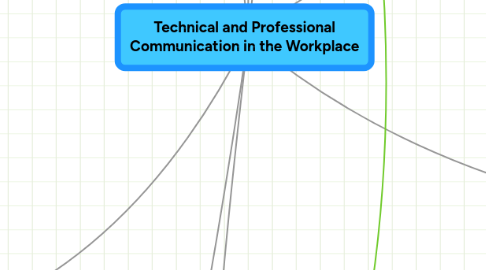
1. Technical Communication in a Transnational World(Ch5)
1.1. Learning about Differences:7 key pts of difference that writers should account for when writing to transnational and transcultural audiences
1.1.1. Language
1.1.2. Technology
1.1.3. Education
1.1.4. Politics
1.1.5. Economics
1.1.6. Society
1.1.7. Religion
2. Visual Rhetoric and Technical Communication(Ch8)
2.1. Visual Rhetoric
2.1.1. Increasing comprehension
2.1.1.1. Clarification
2.1.1.2. Illustration
2.1.1.3. Organization
2.1.1.4. New node
2.2. PSA w Visuals
2.3. Types of graphics
2.3.1. Icons
2.3.2. Bar Graphs(Histograms)
2.3.3. Line Graphs
2.3.4. Pictographs
2.3.5. Charts
2.3.5.1. Pie charts
2.3.5.2. Flowcharts
2.3.5.2.1. Top-down
2.3.5.2.2. Work-flow
2.3.5.2.3. Deployment
2.3.5.2.4. Detailed
2.3.5.3. organizational Charts
2.3.5.3.1. Hierarchical
2.3.5.3.2. Matrix
2.3.5.3.3. Flat
2.3.6. Tables
2.3.6.1. Line drawings
2.4. Types of Images
2.4.1. Photographs
2.4.2. Screen Shots
2.4.3. Video
2.4.4. Animation
2.5. Finding,Capturing,Creating, and Formatting Visuals
2.5.1. Databases
2.5.2. Web Searches
2.5.3. Clip Art
2.5.4. Your Own Visuals
2.5.4.1. Print and Electronic Visuals
2.5.4.2. Software
2.5.4.3. Thumbnails
2.6. Using Color Effectively
2.6.1. To Identify parts of a document or kinds of text
2.6.2. To Highlight or Draw Attention
2.6.3. To improve the Aesthetic and Professional Quality of Documents
2.6.4. How To Add Color
2.6.4.1. Coloring Text
2.6.4.2. Coloring Shapes
2.6.4.3. Coloring Text Boxes
2.6.4.4. Coloring Page Background
2.6.4.5. Adding Color Appropriately
2.6.4.5.1. Color Scheme
2.6.4.5.2. Contrast
2.6.4.5.3. Consistency
2.6.4.5.4. Limited Use
2.7. Guidelines for Using Visuals
2.7.1. Relevance
2.7.2. Size
2.7.3. Simplicity
2.7.4. Transnational Awareness
2.7.4.1. Use Familiar Examples
2.7.4.2. Direct Readers
2.7.4.3. Be Moderate
2.7.4.4. Provide Multiple Examples
2.7.5. Relationship to Written Text
2.7.5.1. Formal Relationship
2.7.5.2. Informal Relationship
2.7.5.3. identification
2.7.5.4. Fluff
2.7.5.5. Revision:PSA
2.8. Ethics and Visuals
2.8.1. Manipulation
2.8.2. Permission
2.8.3. Citation
2.8.4. Accuracy:PSA
2.8.5. Representation
2.8.6. Obfuscation
2.8.7. Concealment
2.8.8. Clarity
2.8.9. Access
3. Organizing and Drafting Documents(Ch7)
3.1. Pre-drafting strategies
3.1.1. Confirm Your Purpose
3.1.2. Analyze Your Audience
3.1.3. Gather your info
3.1.4. Develop Ideas about the info
3.1.4.1. Collaboration and discussion
3.1.4.2. Listing
3.1.4.3. Freewriting
3.1.4.4. Clustering
3.1.5. Organize your info
3.1.5.1. Purpose
3.1.5.2. Audience
3.1.5.3. Logic
3.1.5.4. Ethics
3.1.5.5. Sequential
3.1.5.6. Chronological
3.1.5.7. Order of Importance
3.1.5.8. General/Specific
3.1.5.9. Division
3.1.5.10. Classification
3.1.5.11. Cause/Effect
3.1.5.12. Comparison/Contrast
3.1.5.13. Spatial
3.1.6. Outline Your Important Ideas
3.1.7. Writing the Draft
3.1.7.1. Nonlinear process
3.1.7.2. Drafting the Body
3.1.7.2.1. Coverage and Length
3.1.7.2.2. Organization and Access
3.1.7.3. Draft the Conclusion
3.1.7.4. Draft the Intro
3.1.7.4.1. Purpose/Objective
3.1.7.4.2. Scope
3.1.7.4.3. Statement of the problem
3.1.7.4.4. Relevant info background
3.1.7.4.5. Key Terms
3.1.7.4.6. Overview of Org
3.1.7.4.7. Summary
3.2. ElectronicTemplates and Wizards
4. Technical Instructions(Ch18)
4.1. Ethics and Technical Instructions
4.1.1. Functionality
4.1.2. Safety
4.1.3. Misuse of the product
4.1.4. Hazards even with proper use
4.1.5. Troubleshooting
4.1.6. Product Liability
4.2. Key Elements
4.2.1. Title/Title Image
4.2.2. ByLine
4.2.3. date
4.2.4. Intro
4.2.5. Alerts
4.3. Steps are central to Instructions
4.3.1. Number each step
4.3.2. Perform all steps as you draft them
4.3.3. Begin each step with a verb
4.3.4. Use Positive Commands Whenever Possible
4.3.5. Avoid Highly Condensed Language
4.3.6. Include Only One action per step
4.3.7. Group Similar steps together
4.3.8. Visually seperate steps
4.3.9. Clarify Steps w Visuals
4.3.10. Conclusion
4.3.10.1. Troubleshooting
4.3.10.2. Maintenance info
4.3.10.3. Additional Alerts
4.4. Help Pages
4.4.1. Be Clear,Concise, and Thorough
4.4.2. Be Direct, but friendly
4.4.3. Provide Examples
4.4.4. Provide Links
4.4.5. Include a Search Feature
4.4.6. Consider Context
4.5. Usability of Instructions and Design Concerns
5. Activities(Ch1)
5.1. Characteristics(Ch1)
5.1.1. Rhetorical
5.1.2. Audience Centered
5.1.3. Technology Oriented
5.1.4. Ethical
5.1.5. Research Oriented
5.1.6. Professional
5.1.7. Visual
5.1.8. Design Centered
5.1.9. Concise
5.2. Plan
5.3. Research
5.4. Organizing
5.5. Drafting
5.6. Design
5.7. Integrating Visuals
5.8. Revising
5.9. Rewriting
5.10. Editing
5.11. Testing
5.12. PSA
5.12.1. Plan
5.12.2. Research
5.12.3. Draft
5.12.4. Review
5.12.5. Distribute
5.13. HTW:5 Steps to Successful Writing
5.13.1. Preparation
5.13.2. Research
5.13.3. Organization
5.13.4. Writing
5.13.5. Revision
6. Workplace & Rhetorical Problems(Ch2)
6.1. Exigency and Purpose
6.2. Audience
6.3. Workplace Writers
6.4. Contexts and Constraints
6.5. Documents
7. Technical Comm and Electronic Technologies(Ch3)
7.1. Creating Documents
7.1.1. Word Processors
7.1.2. Presentation Software
7.1.3. Graphics and Imaging Software
7.1.4. Web-Authoring Software
7.1.5. Desktop Publishing Software(DTP)
7.1.6. Help and E-learning Authoring Tools
7.1.7. Single-Sourcing Programs
7.2. Communication and Collaborating
7.2.1. The Internet
7.2.2. World Wide Web(WWW)
7.2.3. E-mail
7.2.4. Ethics and Electronic Communication
7.2.5. Electronic Messaging
7.2.6. Video Conferencing
7.2.7. Groupware
7.3. The Future of Workplace Writing and Computer Technology
7.3.1. Wireless Technology(WiFi)
7.3.2. Bandwidth and connection speed
7.3.3. Integration and portability
7.3.4. Prices
7.3.5. Transnationalism
8. Ethics and the Workplace Writer(Ch4)
8.1. What is Ethics?
8.1.1. Ethics and the Workplace Writer
8.2. Ethical Guidelines for Workplace Writers
8.2.1. Guideline#1:Ethics and Laws Are Not the Same
8.2.2. Guideline#2:Be Honest
8.2.3. Guideline#3: Respect Confidentiality
8.3. Ethics in Context
8.3.1. Situation and Perspective
8.3.2. Circulation
8.3.3. Revision and Editing
8.4. Ethics and Technology
8.4.1. Email
8.4.2. Websites
8.4.3. Visuals
8.5. Environmental Ethics
8.6. Avoiding Unethical Writing
8.6.1. Dont Use Deceptive or Evasive Language
8.6.2. Dont Obscure or Misrespresent the Issue
